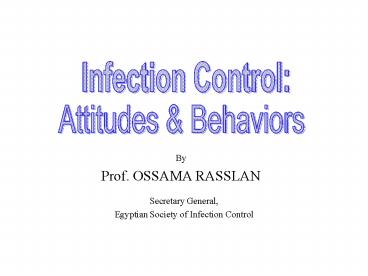Infection Control: - PowerPoint PPT Presentation
Title:
Infection Control:
Description:
the planning process should be undertaken. The cornerstone of this process is assessment ... Not proscriptive, but collegial. Appeal to people's knowledge & logic ... – PowerPoint PPT presentation
Number of Views:53
Avg rating:3.0/5.0
Title: Infection Control:
1
Infection Control
Attitudes Behaviors
By Prof. OSSAMA RASSLAN
Secretary General, Egyptian Society of Infection
Control
2
How does one affect change?
- Changing H.C. worker behaviors is a challenge
- Before beginning any program to change
- the planning process should be undertaken
- The cornerstone of this process is assessment
Attitudes behaviors
3
Assessment
- Until you understand who, what, when why,
- you cannot design a program that will be
successful - Assessment helps the ICP understand both
individual - organizational factors that lead to a behavior
- It helps the ICP determine the priorities for
change - It provides the baseline against which change
can - be measured
Attitudes behaviors
4
Components of the Assessment
- I. Factors related to the individual H.C.Worker
- Sociodemographic characteristics
- Knowledge educational level
- Attitudes
- Beliefs
Attitudes behaviors
5
Components of the Assessment
- II. Organizational Factors
- Resources
- Staffing
- Local regional laws
- Organizational support for a behavior
Attitudes behaviors
6
Strategies for change
- Are based on the assessment prioritization
- of the factors found
- Once a plan is implemented, re-assessment
- can show success or failure in the program
Attitudes behaviors
7
Hints for success
- Involve the target audience
- Work at all levels of the org. to get support
- Use positive reinforcements
- Acknowledge the inclusion of IC professionals
- as persons who may need to change
Attitudes behaviors
8
Assessment of attitudes behaviors
- Assessment is the cornerstone of program
planning - (Include programs to change HCW behaviors)
- Systematic evaluation
- Identification of places to intervene
- Establishment of a baseline against which
- to evaluate change
Attitudes behaviors
9
Epidemiol. approach to behavior assessment
- Who is doing?
- What are the attributes behaviors?
- Where does it happen? In what context?
- When does the behavior happen?
- Why (what are the reasons for the behavior?)
Attitudes behaviors
10
Who The Target Audience
- Physicians
- Nurses
- Family members
- Lay health workers aides
- Infection control personnel
Attitudes behaviors
11
What are the behaviors?
- Handwashing
- Use of barriers or isolation procedures
- Antibiotic prescribing
- Equipment handling procedures
- Procedures to protect worker safety
Attitudes behaviors
12
Look at the behavior
- Is it right?
- Is it important
- Is there a standard?
- Is it effective?
- Is it realistic?
- Prioritize
Attitudes behaviors
13
Where is it happening?
- What type of facility?
- During which activity?
- What are the characteristics of the place
- in which it occurs?
- When is it happening?
- In emergencies or during normal care
- Time of day, day of week, or season
Attitudes behaviors
14
Why Individual reasons for behavior
- Age Beliefs
- Education Attitudes
- Profession Cues to action
- Gender Reinforcement
- Geographic location Self-efficacy
- Knowledge
Attitudes behaviors
15
Why Individual reasons for behavior
- Knowledge
- It is rarely the only reason for behavior
- Beliefs
- Perceived susceptibility to health threat
- Perceived severity of the threat
- Belief that the behavior will be beneficial
Attitudes behaviors
16
Why Individual reasons for behavior
- Attitudes
- Time
- Convenience
- Opinion of the behavior its importance
- Cues to action
- Triggers
- Reminders
- Presence of IC personnel
- Social pressure
Attitudes behaviors
17
Why Individual reasons for behavior
- Reinforcement
- Positive or negative
- Performance feedback
- Self-efficacy
- Perceived ability to do the desired behavior
- Perceived control
Attitudes behaviors
18
Why Organiz. reasons for behavior
- Resources
- Engineering
- Staffing
- Administrative leadership
- Administrative sanctions
Attitudes behaviors
19
Planning for behavior change
- (should be based on assessment)
- Example Hand Hygiene
- to illustrate the many factors that influence
behavior - Who HC workers
- What compliance with H.W. standards
- Where a H.C. facility (type?)
- When - In emergency or during normal care
- - Time ?
Attitudes behaviors
20
Hand Hygiene Reasons for noncompliance
- I. Individuals
- Knowledge Lack of scientific info wearing
gloves - Beliefs (that interfere with HCW-patient
- relationship)
- Attitudes Too busy
- Cues Lack of role model
- Reinforcements Lacking
- Self-efficacy Lack of time Pt needs priority
Attitudes behaviors
21
Hand Hygiene Reasons for noncompliance
- II. Organization
- Inaccessible supplies
- Staffing
- Lack of institutional priority
- Lack of administrative sanctions or rewards
Attitudes behaviors
22
Planning strategies for behavior change
- Type of strategy not always education
- Too busy time mgt
- Peer pressure assertiveness training
- Knowledge education
- Resources administrative commitment
Attitudes behaviors
23
Strategies for behavior change
- Begin with OUR behavior
- Not proscriptive, but collegial
- Appeal to peoples knowledge logic
- Involvement leads to ownership
- Empowerment leads to self-efficacy
- Change social norms to maintain
- behavior change
Attitudes behaviors
24
Strategies for behavior change
- Involve the leaders influential persons
- (formal informal leaders)
- Work at every level of the org. to make
- change happen
- Apply the basic concepts
- Keep it simple, applicable, achievable
- affordable
Attitudes behaviors
25
Strategies for behavior change
- Use reinforcements cues
- - Positive reinforcements
- - Negative reinforcements
- (when all else fails)
- - Repeat over time
Attitudes behaviors
26
Strategies for behavior change
- Celebrate success, review failure
- - Communicate results share successes
- failures with staff
- - Repeat assessment planning process
- - Include yourself in the change process
- - Trust in yourself others!
Attitudes behaviors
27
Thank You































